Architecture Bauhaus-Museum with ladder to heaven
- Written by Portal Editor
In our article about the new Bauhaus Museum in Weimar we had already briefly touched on the building architecture with its very closed facade, a design by the architect Heike Hanada in collaboration with Benedict Tonon.
This design shows a minimalist cube as a geometrically simple building on the edge of Weimarhallenpark.
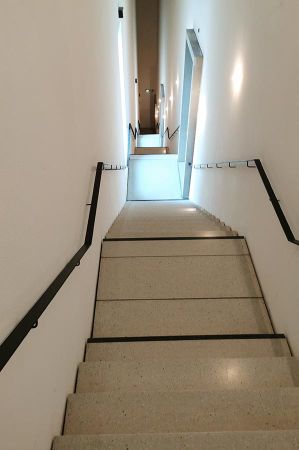 The facade of the building is made of cast concrete, which is only structured by horizontal glass bands that are interrupted by black stripes.
The facade of the building is made of cast concrete, which is only structured by horizontal glass bands that are interrupted by black stripes.
This very closed facade also made it possible to design a so-called ladder to heaven, which we were able to experience ourselves as we left the building.
In architecture, the sky ladder is the name given to a specific type of staircase, which was used in medieval buildings, especially in Munich.
Here in Weimar, the “descent” from the top floor of the museum is impressive, just in terms of height.
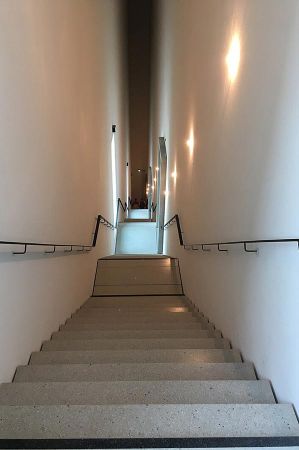 A ladder to heaven is basically “just” a straight staircase that connects several floors. Most of the time, as in the Bauhaus Museum, it is directly bordered on both sides by the wall of the stairwell, so that the stairwell does not take up a larger area than that of the stairs. The respective landing is located at the entrances to the individual floors. From the bottom of the stairs, you can see all the way to the top floor or vice versa, which is impressive in the Bauhaus Museum simply because of the height of the building and therefore the length of the stairs. This creates the impression, similar to the outdoor stairways to heaven, that the stairs reach up to heaven.
A ladder to heaven is basically “just” a straight staircase that connects several floors. Most of the time, as in the Bauhaus Museum, it is directly bordered on both sides by the wall of the stairwell, so that the stairwell does not take up a larger area than that of the stairs. The respective landing is located at the entrances to the individual floors. From the bottom of the stairs, you can see all the way to the top floor or vice versa, which is impressive in the Bauhaus Museum simply because of the height of the building and therefore the length of the stairs. This creates the impression, similar to the outdoor stairways to heaven, that the stairs reach up to heaven.
This type of construction became common in Munich from the late Middle Ages. For example, in the Ignaz Günther House there is a three-story ladder to heaven from the 15th century, and in the house at Sternenckerstrasse 2 there is a four-story ladder to heaven from the 16th century. This construction method was favoured by the shape of the properties in Munich's old town, which were often deep and narrow.
Heaven's ladder or Jacob's ladder in religious belief
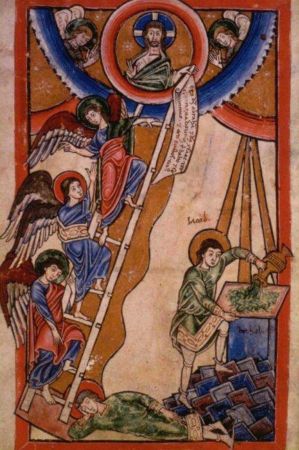 The term "ladder to heaven" is not only known in architecture, as it originally comes from the Bible, because Jacob's ladder or ladder to heaven is an ascent and descent between earth and heaven, which Jacob climbed during, according to the biblical story in Gen 28.11 EU during his flight from Esau from Beer Sheva to Harran in a dream vision.
The term "ladder to heaven" is not only known in architecture, as it originally comes from the Bible, because Jacob's ladder or ladder to heaven is an ascent and descent between earth and heaven, which Jacob climbed during, according to the biblical story in Gen 28.11 EU during his flight from Esau from Beer Sheva to Harran in a dream vision.
This ladder to heaven stood on earth and its top reached into the sky. On it he sees angels of God ascending and descending, but above stands the Lord himself, who introduces himself to him as the God of Abraham and Isaac and renews the promise of land and offspring.
After awakening, Jacob calls the place the house of God or the gate of heaven.
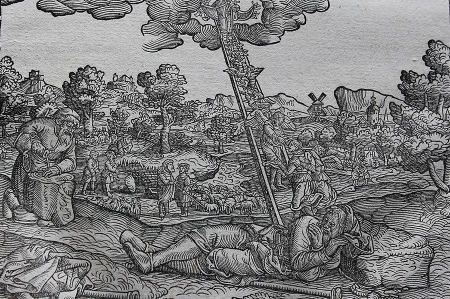 Adapted again and again and changed through translations, the term “ladder” became predominant in the Western visual tradition. The Hebrew word sullām can also be translated as “stairs”, “staircase” or “ramp” and can be understood as the Akkadian equivalent of simmiltu (staircase, step ramp). This corresponds to the ancient oriental idea of a path to heaven and a path to the underworld. In Assyrian and Mesopotamian texts, stairs to heaven are used by gods and messengers of the gods, but also by beings of the underworld.
Adapted again and again and changed through translations, the term “ladder” became predominant in the Western visual tradition. The Hebrew word sullām can also be translated as “stairs”, “staircase” or “ramp” and can be understood as the Akkadian equivalent of simmiltu (staircase, step ramp). This corresponds to the ancient oriental idea of a path to heaven and a path to the underworld. In Assyrian and Mesopotamian texts, stairs to heaven are used by gods and messengers of the gods, but also by beings of the underworld.
Protestant biblical scholarship considers the image of the ancient oriental ziggurat as a model to be rather unlikely. Although Ziggurat is said to have first emerged as a “world mountain” or “primordial hill” during creation from the Sea of Chaos, there is only evidence of the name for the Ziggurat in Sippar (discovery site near Baghdad); such buildings are completely missing in Canaan or Palestine. Nevertheless, it cannot be ruled out that at least the motif “Mountain of the Lord” according to Ps 24:1-3 EU is a ziggurat, without there necessarily being a connection to Jacob's ladder.
Historically, the place name Bet-El is probably pre-Israelite, i.e. older than the Jacob story, which explains it and at the same time claims it for the history of Israel.
The term ladder to heaven is deeply rooted – in art too!
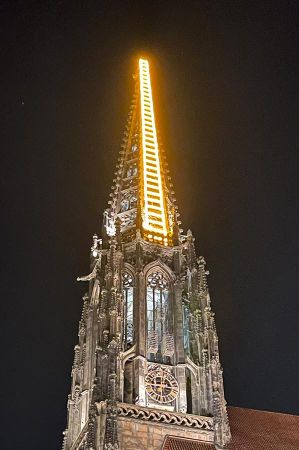 The installation “Himmelsleiter” by the Viennese light artist Billi Thanner, which has been shining on the tower of the Lamberti Church in Münster since September 2022, shows this more than clearly. The 48-meter-high “Ladder to Heaven,” which is permanently installed both on the outer tower (36 meters) and in the interior (12 meters) of the church, is now an integral part of the cityscape and enjoys great popularity. The work of art was turned on for the first time in the showroom at the beginning of September, and since then it has been visible from far away, and for many people from dusk to dawn it has become a fixed point in the dark night and a symbol of hope. For Billi Thanner, however, it is something more: the sprouts stand for virtues such as love, mindfulness or gratitude - and for “never losing faith in the good”. She is very moved by the fact that her work has such an enormous impact on the city's population: “I am very happy that we managed to extend the art installation. Thank you to the people of Münster for your love of art!”
The installation “Himmelsleiter” by the Viennese light artist Billi Thanner, which has been shining on the tower of the Lamberti Church in Münster since September 2022, shows this more than clearly. The 48-meter-high “Ladder to Heaven,” which is permanently installed both on the outer tower (36 meters) and in the interior (12 meters) of the church, is now an integral part of the cityscape and enjoys great popularity. The work of art was turned on for the first time in the showroom at the beginning of September, and since then it has been visible from far away, and for many people from dusk to dawn it has become a fixed point in the dark night and a symbol of hope. For Billi Thanner, however, it is something more: the sprouts stand for virtues such as love, mindfulness or gratitude - and for “never losing faith in the good”. She is very moved by the fact that her work has such an enormous impact on the city's population: “I am very happy that we managed to extend the art installation. Thank you to the people of Münster for your love of art!”
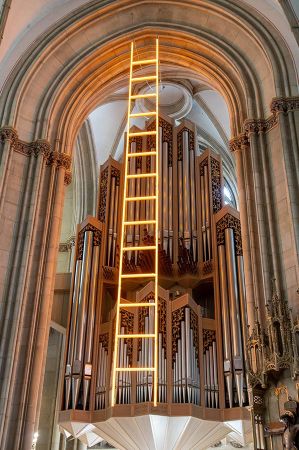 2023 marks the 375th anniversary of the Peace of Westphalia - the city of Münster has been preparing for this special anniversary year with many actors and partners from city society for some time. This not only focuses on history, but also focuses on the present and future with their challenges and opportunities. This explains the intention of the artist, the city and the parish to keep the ladder to heaven with its enormous symbolic and radiant power in place. The art installation will therefore remain in Münster longer than initially expected. According to the original planning, it should have been dismantled in March 2023 and brought to Vienna.
2023 marks the 375th anniversary of the Peace of Westphalia - the city of Münster has been preparing for this special anniversary year with many actors and partners from city society for some time. This not only focuses on history, but also focuses on the present and future with their challenges and opportunities. This explains the intention of the artist, the city and the parish to keep the ladder to heaven with its enormous symbolic and radiant power in place. The art installation will therefore remain in Münster longer than initially expected. According to the original planning, it should have been dismantled in March 2023 and brought to Vienna.
Goodbye in Vienna?
For a year and a half, Austrian artist Billi Thanner's Ladder to Heaven was part of the city panorama in Münster. Professional climbers have now dismantled the light installation in a two-day campaign.
Please read as well:
Bauhaus Museum – art, crafts and industry at start of the 1920s